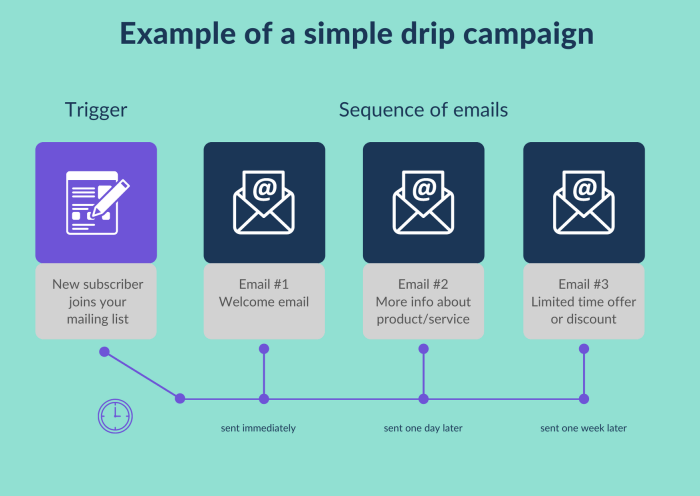Email Marketing Campaigns dive deep into the world of digital marketing, exploring their significance and impact with a fresh perspective. This topic is all about mastering the art of email campaigns, from defining their goals to crafting compelling content that resonates with audiences. Get ready to revolutionize your marketing game with these innovative strategies!
Overview of Email Marketing Campaigns
Email marketing campaigns are a crucial component of digital marketing strategies, allowing businesses to reach a large audience directly through their inbox. These campaigns involve sending targeted emails to customers and potential customers to promote products, services, or events.
Goals and Objectives of Email Marketing Campaigns
- Increasing brand awareness
- Driving traffic to a website or landing page
- Generating leads and sales
- Building customer loyalty and retention
Successful Email Marketing Campaign Examples
- Starbucks: Personalized offers and rewards program updates
- Amazon: Product recommendations based on past purchases
- Dollar Shave Club: Engaging and humorous content to retain customers
Benefits of Email Marketing Campaigns
- Cost-effective compared to traditional marketing channels
- Highly targeted and personalized messaging
- Measurable results with analytics and tracking tools
- Ability to reach customers on their preferred communication platform
Key Elements of an Email Marketing Campaign

When it comes to a successful email marketing campaign, there are several key components that play a crucial role in its effectiveness. From personalized content to engaging subject lines and compelling call-to-action buttons, each element contributes to the overall success of the campaign.
Personalized Content
Personalization is essential in email marketing campaigns as it helps to create a more tailored experience for the recipients. By addressing the recipients by their name, segmenting the audience based on their preferences, and sending targeted content that resonates with them, you can significantly increase engagement and conversion rates.
- Address recipients by their name to create a sense of familiarity and connection.
- Segment your audience based on their interests, behaviors, or demographics to send relevant content.
- Use dynamic content to personalize emails based on the recipient’s past interactions with your brand.
Subject Lines and Preview Text
The subject line and preview text are the first things recipients see when they receive an email, making them crucial in determining whether the email will be opened or ignored. Compelling subject lines and preview text can grab the recipient’s attention and entice them to open the email.
- Create clear and concise subject lines that convey the value or benefit of opening the email.
- Use preview text strategically to provide a sneak peek of the email content and encourage opens.
- A/B test different subject lines and preview text to see what resonates best with your audience.
Call-to-Action (CTA) Buttons
CTA buttons are a vital component of an email marketing campaign as they direct recipients on what action to take next after reading the email. Whether it’s making a purchase, signing up for a webinar, or downloading a resource, a clear and compelling CTA button can drive conversions and lead to measurable results.
- Use action-oriented language on CTA buttons to prompt recipients to take the desired action.
- Ensure CTA buttons stand out visually with contrasting colors and placement within the email.
- Optimize CTA buttons for mobile devices to make it easy for recipients to click and convert.
Building an Email List for Campaigns

Building an email list is crucial for the success of your marketing campaigns. Without a targeted list of engaged subscribers, your emails may end up in the spam folder or get ignored. Here are some strategies to help you build a strong email list:
Opt-In Forms and Incentives
When creating opt-in forms on your website or landing pages, make sure they are easy to find and use. Offer valuable incentives such as discounts, free resources, or exclusive content in exchange for email sign-ups. This will encourage visitors to subscribe and provide their contact information.
Segmentation for Targeted Campaigns, Email Marketing Campaigns
Segmentation involves dividing your email list into smaller groups based on specific criteria such as demographics, interests, or past behavior. By sending targeted emails to segmented lists, you can increase open rates, click-through rates, and conversions. Personalized emails are more likely to resonate with subscribers and lead to better results.
Maintaining an Engaged Email List
To keep your email list healthy and engaged over time, regularly clean your list by removing inactive subscribers. Send relevant and valuable content to your subscribers to keep them interested and prevent them from unsubscribing. Encourage feedback and interaction by asking for opinions or conducting surveys to understand your subscribers’ preferences better.
Design and Content Creation for Email Marketing
In the world of email marketing, design and content creation play a crucial role in capturing the attention of your audience and driving engagement. From responsive design to compelling visuals and engaging copy, there are key elements to consider when crafting successful email campaigns.
Importance of Responsive Design
Responsive design is essential in email marketing campaigns because it ensures that your emails are optimized for viewing on various devices, including smartphones, tablets, and desktops. By using responsive design techniques, you can create emails that adapt to different screen sizes, providing a seamless user experience for your audience.
Best Practices for Creating Compelling Visuals and Graphics
- Use eye-catching images that are relevant to your message.
- Incorporate your brand colors and logo for brand recognition.
- Keep the design clean and uncluttered to avoid overwhelming the reader.
- Use high-quality graphics that enhance the overall look of your email.
Tips for Crafting Engaging Copy
- Personalize your message to make it more relatable to the recipient.
- Keep your copy concise and to the point to maintain the reader’s interest.
- Use a conversational tone to create a connection with your audience.
- Include a clear call-to-action to guide the reader on the next steps.
Role of Storytelling in Email Marketing
Storytelling can be a powerful tool in email marketing as it allows you to connect with your audience on an emotional level. By weaving a compelling narrative into your emails, you can capture the attention of your readers and keep them engaged with your brand. Storytelling helps humanize your brand and creates a memorable experience for your audience, ultimately leading to higher engagement and conversions.